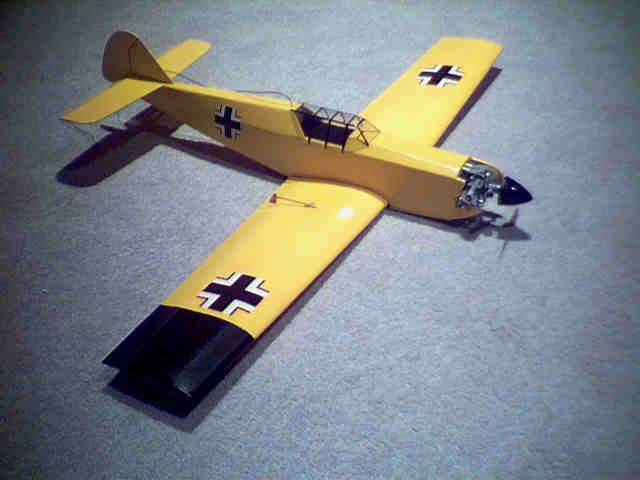 |
This is an excellent introduction to
the sport of pylon racing. That's the author's ME 109 on
the left. The "simple series" from Acer RC are
allowed, and can be purchased directly from Norvel in a
kit for about $60 kit, including the Norvel .049 engine
(no throttle control). Click through to the Norvel web site. The alternative is the Cox TD 049
engine. Engines and kits can be bought from your local
hobby store, if it's reasonable stocked with
aeromodelling stuff, but the kits are a little hard to
find. The choice of aircraft for
racing is the ME 109 , the P51D Mustang and the AT 6
Texan. I've seen one other aircraft type at the races,
but don't know what it is. Check at the competitor gallery.
|
 Races are
run around pylons placed about 300 feet apart.
Aircraft fly fast, and turn left ! You have 1
minute to your engines before the throwers lines
up to launch the planes. The starter then waves
his green flag, and the planes are launched
towards the first pylon. Races are often lost and
won on an ability to get the engines started in
time to launch, and have them run reliably.
Several of the well-tuned planes seemed to run
out of fuel before the 10 lap races are over !
Launching can be a tricky business too, and a bad
launch can end with a droop onto the tarmac
instead of a steady climb. Races are
run around pylons placed about 300 feet apart.
Aircraft fly fast, and turn left ! You have 1
minute to your engines before the throwers lines
up to launch the planes. The starter then waves
his green flag, and the planes are launched
towards the first pylon. Races are often lost and
won on an ability to get the engines started in
time to launch, and have them run reliably.
Several of the well-tuned planes seemed to run
out of fuel before the 10 lap races are over !
Launching can be a tricky business too, and a bad
launch can end with a droop onto the tarmac
instead of a steady climb.
|
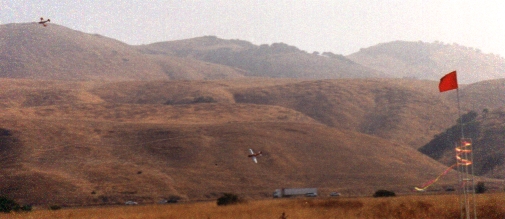 The race runs over a 10
lap course around the pylons. Spotters watch to
see that planes do cross the line of the pylons,
and mark down any that don't. Violations incur a
penalty lap, which is as good as loosing the
race, and gives the novices a chance to get into
the points. You can often pick up
a place in a race because others cut inside the
pylons and incur a penalty lap. Several heats are
run, and points are awarded - 4 points for first
place, 3 for second place, 2 for third place, and
1 for fourth. No points if you don't finish the
race. So limping over the finish line when others
have already failed to complete the course can
still will you points. The race runs over a 10
lap course around the pylons. Spotters watch to
see that planes do cross the line of the pylons,
and mark down any that don't. Violations incur a
penalty lap, which is as good as loosing the
race, and gives the novices a chance to get into
the points. You can often pick up
a place in a race because others cut inside the
pylons and incur a penalty lap. Several heats are
run, and points are awarded - 4 points for first
place, 3 for second place, 2 for third place, and
1 for fourth. No points if you don't finish the
race. So limping over the finish line when others
have already failed to complete the course can
still will you points.
|
|

 Races are
run around pylons placed about 300 feet apart.
Aircraft fly fast, and turn left ! You have 1
minute to your engines before the throwers lines
up to launch the planes. The starter then waves
his green flag, and the planes are launched
towards the first pylon. Races are often lost and
won on an ability to get the engines started in
time to launch, and have them run reliably.
Several of the well-tuned planes seemed to run
out of fuel before the 10 lap races are over !
Launching can be a tricky business too, and a bad
launch can end with a droop onto the tarmac
instead of a steady climb.
Races are
run around pylons placed about 300 feet apart.
Aircraft fly fast, and turn left ! You have 1
minute to your engines before the throwers lines
up to launch the planes. The starter then waves
his green flag, and the planes are launched
towards the first pylon. Races are often lost and
won on an ability to get the engines started in
time to launch, and have them run reliably.
Several of the well-tuned planes seemed to run
out of fuel before the 10 lap races are over !
Launching can be a tricky business too, and a bad
launch can end with a droop onto the tarmac
instead of a steady climb.  The race runs over a 10
lap course around the pylons. Spotters watch to
see that planes do cross the line of the pylons,
and mark down any that don't. Violations incur a
penalty lap, which is as good as loosing the
race, and gives the novices a chance to get into
the points. You can often pick up
a place in a race because others cut inside the
pylons and incur a penalty lap. Several heats are
run, and points are awarded - 4 points for first
place, 3 for second place, 2 for third place, and
1 for fourth. No points if you don't finish the
race. So limping over the finish line when others
have already failed to complete the course can
still will you points.
The race runs over a 10
lap course around the pylons. Spotters watch to
see that planes do cross the line of the pylons,
and mark down any that don't. Violations incur a
penalty lap, which is as good as loosing the
race, and gives the novices a chance to get into
the points. You can often pick up
a place in a race because others cut inside the
pylons and incur a penalty lap. Several heats are
run, and points are awarded - 4 points for first
place, 3 for second place, 2 for third place, and
1 for fourth. No points if you don't finish the
race. So limping over the finish line when others
have already failed to complete the course can
still will you points.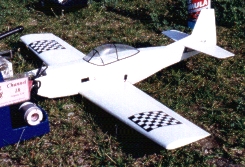
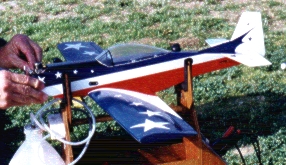
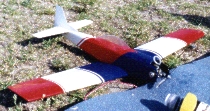

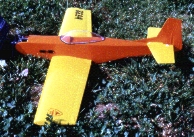
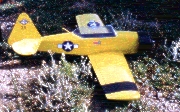
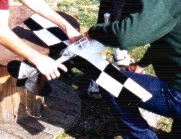 AT-6 Texans
AT-6 Texans

